Everyone is talking about the price of eggs these days. Food prices are skyrocketing; in the past year we have had shortages of critical items. The Chinese have a long history of eating healthy, despite scarcity. In America, most of us are one or two generations removed from family who survived the scarcity of the Great Depression and World War II. Our predecessors knew how to eat healthy on a budget, and we can all learn from their history.
“Chinese cooking is a cooking of scarcity. …The vast majority of Chinese spent their lives short of fuel, cooking oil, utensils, and even water…. Chinese ingenuity has gone into designing the most versatile possible tools that can be used for every imaginable task.”
Anderson, Eugene N. 1987. The Food of China, p. 182.
I buy my eggs from an elderly couple who keep a home flock of chickens. The other day we were talking, and I asked if they ever raised chickens for meat. The gentleman explained to me that while he and his wife do not enjoy the butchering process, they do raise chickens for their own consumption. Typically, they buy chicks in the fall, and they are ready for harvest in as little as seven weeks. (See also Backyard Poultry: Fresh Eggs at Home.) I was surprised to learn that they only require six birds to get enough meat for a year. He explained that the modern breeds of meat birds are large, with breasts that weigh more than a pound after butchering. However, the key point was that he and his wife stretch this meat by incorporating it into vegetable stir-fries with food from their garden. That is true of home style Chinese recipes too.
How to stretch your food budget with Chinese recipes
For example, a typical Western dinner of grilled chicken breast and a salad would use one breast per person. However, Cold Shredded Chicken Salad or Kung Pao Chicken, Homestyle can stretch a single chicken breast to feed three or four people while incorporating healthy vegetables like carrots and cucumbers. These recipes use a minimum of oil and starch, so most of the carbohydrates and fats come from the food itself.
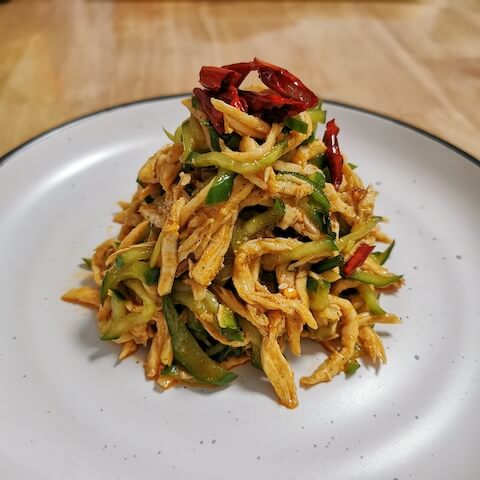
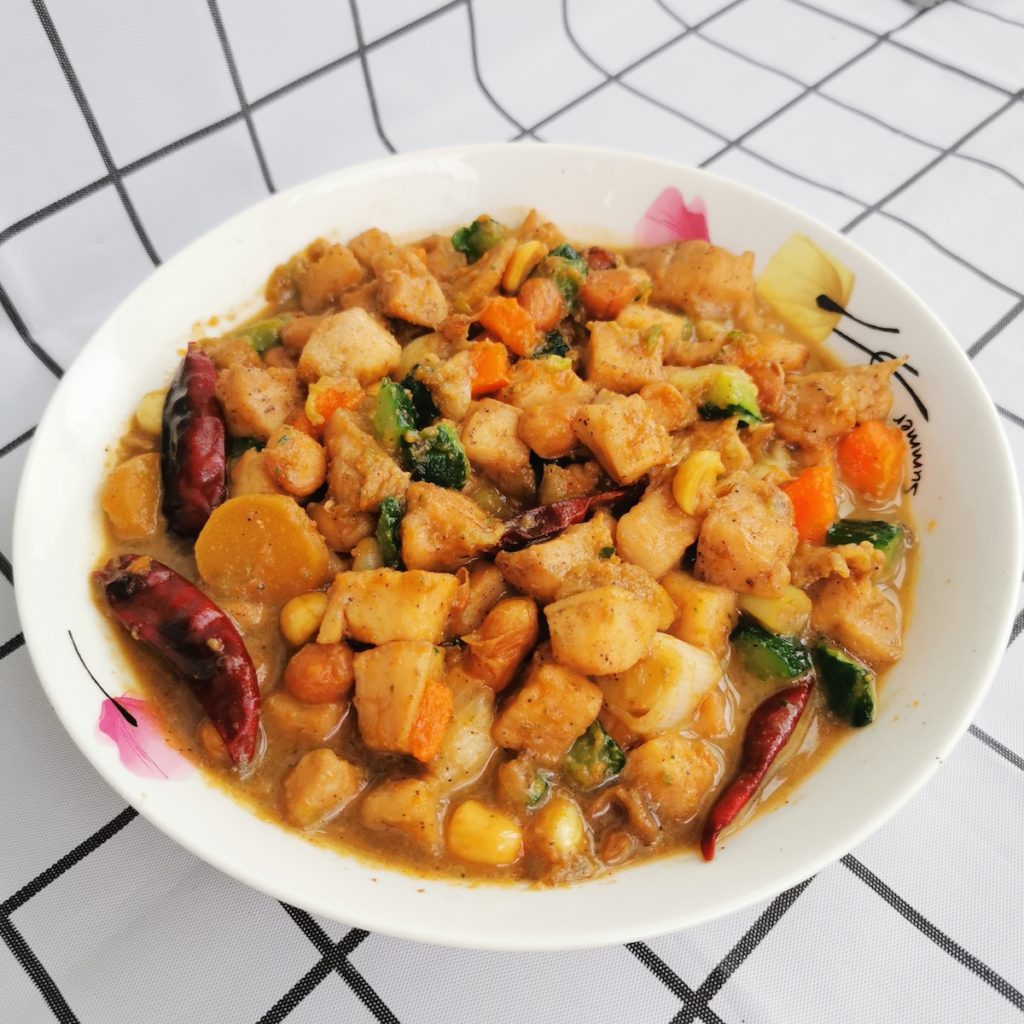
I recently purchased fresh chicken breast at the grocery, for $4.19 per pound. Last summer, the price had gotten as high as $6.00 per pound. For illustration let’s compare a Western and Chinese dinner. The Western dinner is healthy, with grilled chicken breast, some steamed broccoli, and a garden salad. The Chinese dinner is healthy, with Kung Pao Chicken containing carrot, cucumber, peanuts, ginger, garlic, and green onion.
For simple comparison, since the amounts of vegetable are about the same, consider that the Western grilled chicken breast dinner feeds four at the cost of $16.76 (for the four breasts), whereas the Chinese Kung Pao chicken dinner feeds the same four people at the cost of $4.19 for a one pound chicken breast. If you want to take this further, add a second dish such as fried pork belly with green peppers, and a white mushroom soup. That adds $5 for the pound of pork belly, and $2 for the mushrooms, for a total $11.19.
Is there such a thing as healthy Chinese food?
As I have been learning from Jing, I have come to realize that the Chinese are experts at eating healthy on a budget. Please note, I am not referring to Chinese-American takeout food like General Tso’s Chicken or fried egg rolls. On My Chinese Home Kitchen, we do offer a mix of restaurant dishes and home cooking. We also include some popular street food recipes that are not the healthiest. However, the authentic traditional recipes, like Mapo Tofu, Kung Pao Chicken, Pork-stuffed Peppers, and Home Style Twice Cooked Pork, and Jing’s home recipes like Fried Pork Belly with Chili, Cumin Squid Tentacles with Chili, Dry Pot Braised Shrimp, Hot and Sour Shredded Potatoes, and Long Beans & Pork are healthy, delicious, economical meals.
For those on a low-carbohydrate diet, we offer nearly 60 recipes (and the number is growing) that contain less than 20 grams of carbohydrate per serving.

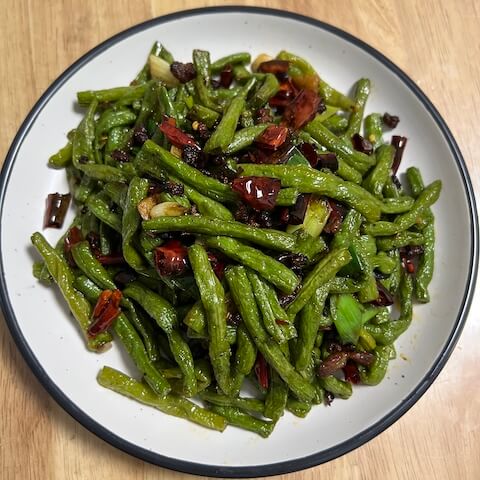

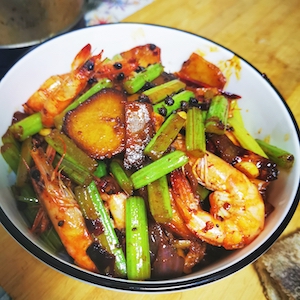
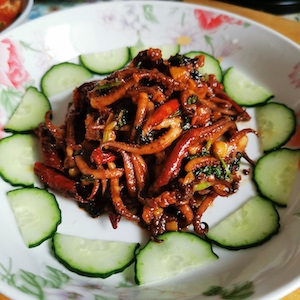

Eating healthy on a budget requires a different mindset
Today, the brilliant harmony of Chinese cooking is gaining recognition. Chinese cuisine uses spare amounts of protein and a minimum of oil.… Herbs and foods like ginseng, soybeans, gingko nuts, and ginger, which the Chinese have integrated into their diet for thousands of years, are now being accepted by the West as particularly beneficial for health. Many of the vegetables in the Chinese diet, especially greens like bok choy, are rich in beta carotene, other vitamins, phytochemicals, and minerals, and the favored technique of stir-frying preserves the vegetables’ nutrients.
Young, Grace. The Wisdom of the Chinese Kitchen: Classic Family Recipes for Celebration and Healing
There’s a Chinese philosophy of eating that requires a shift in thinking for Westerners. Westerners typically focus on the main dishes, but Chinese focus on the rice. Rice is the staple. The entrees are used to “send the rice,” adding flavor to the rice by serving as a topping. In other words, the rice is not a side dish, but the main dish, to be enjoyed with samplings of the entrees. The goal is to stretch the expensive ingredients, like meat, by incorporating with vegetables and soup.
White rice, even in its enriched variety is not the healthiest choice. (See Healthy Eating: Rice.) Parboiled rice is a better choice if you want a similar texture, and brown rice is the best choice for fiber, nutrition, and low glycemic index.
You do not have to go 100 percent Chinese in your cooking. Add a Chinese dish to a Western meal. Make steamed vegetables from your garden to serve with a Chinese dish, for example.

Do you enjoy My Chinese Home Kitchen?
We enjoy sharing these authentic home recipes with you. My Chinese Home Kitchen is a labor of love.
Please tell your friends about us!
Learn more about My Chinese Home Kitchen at our About page.
Please leave a comment, or SUBSCRIBE to our newsletter.
For more of our original videos, visit My Chinese Home Kitchen on YouTube and Rumble.


